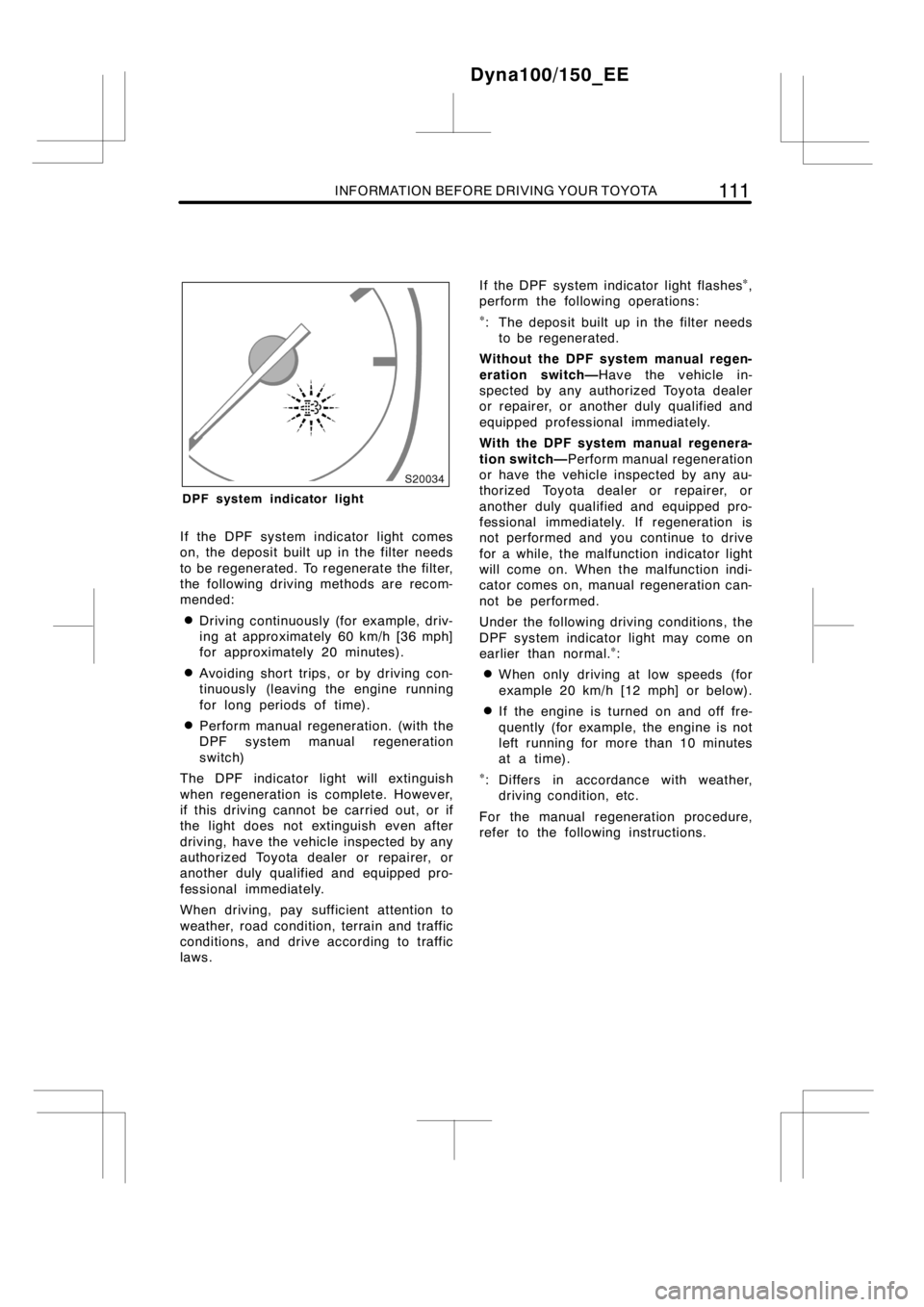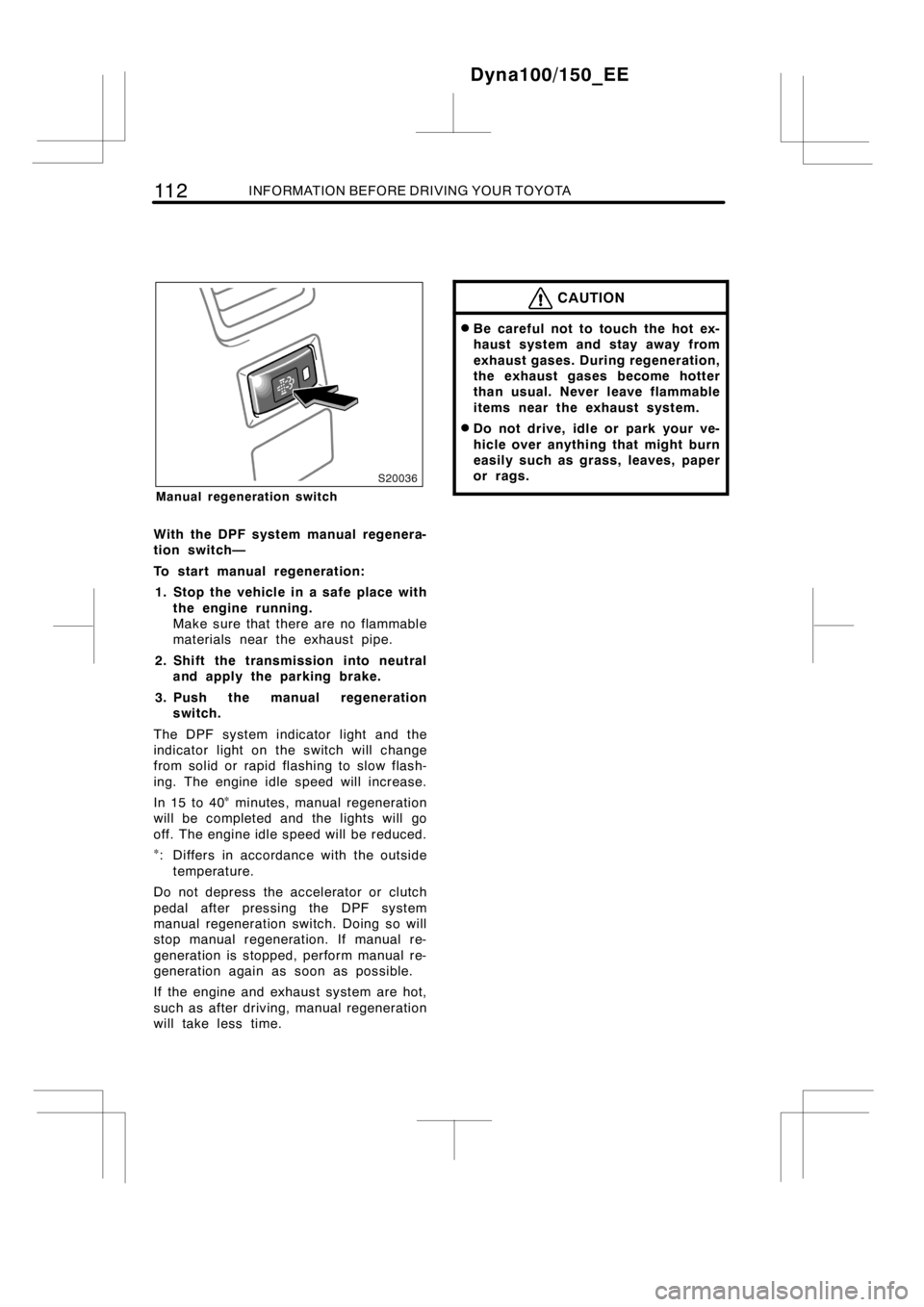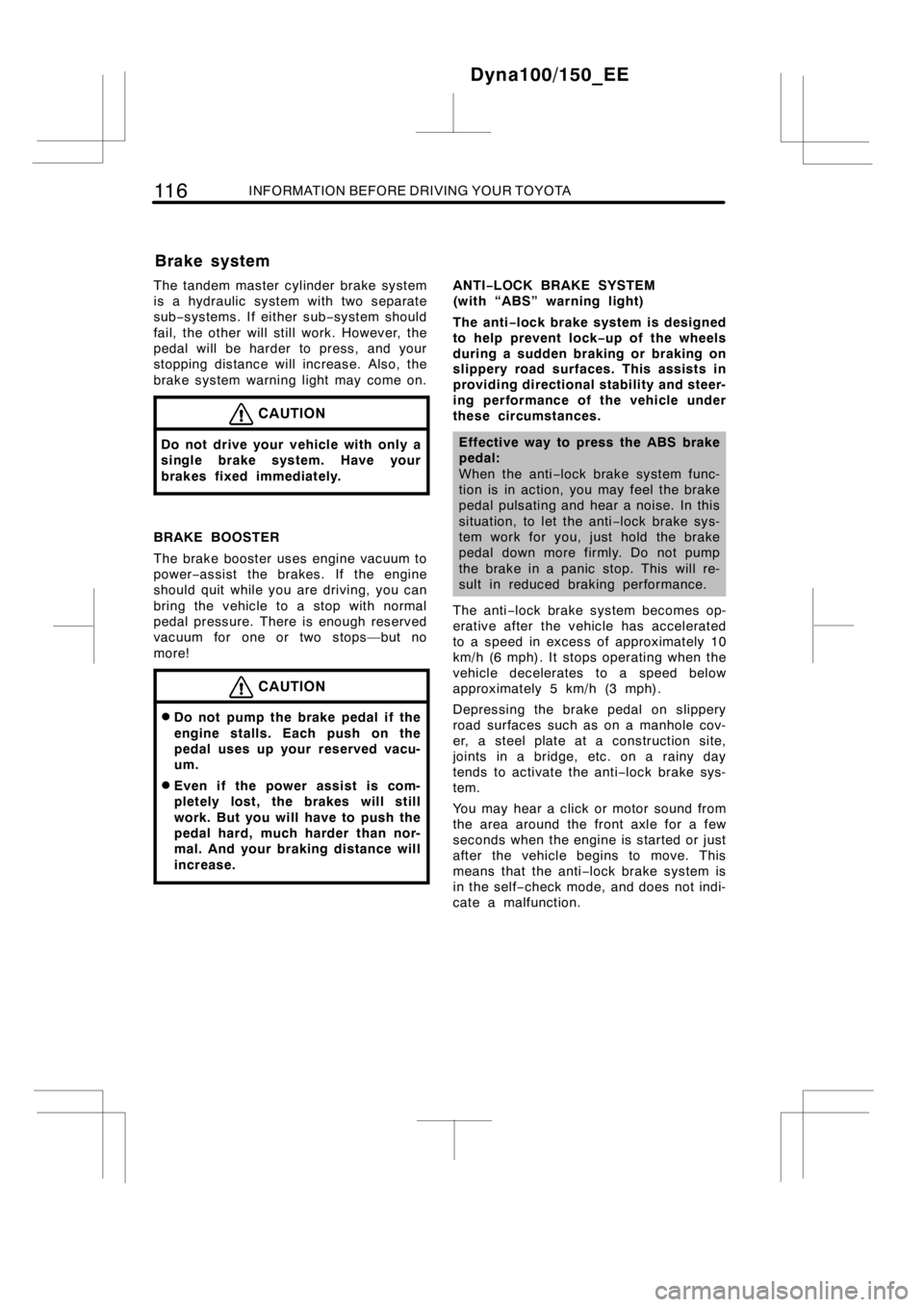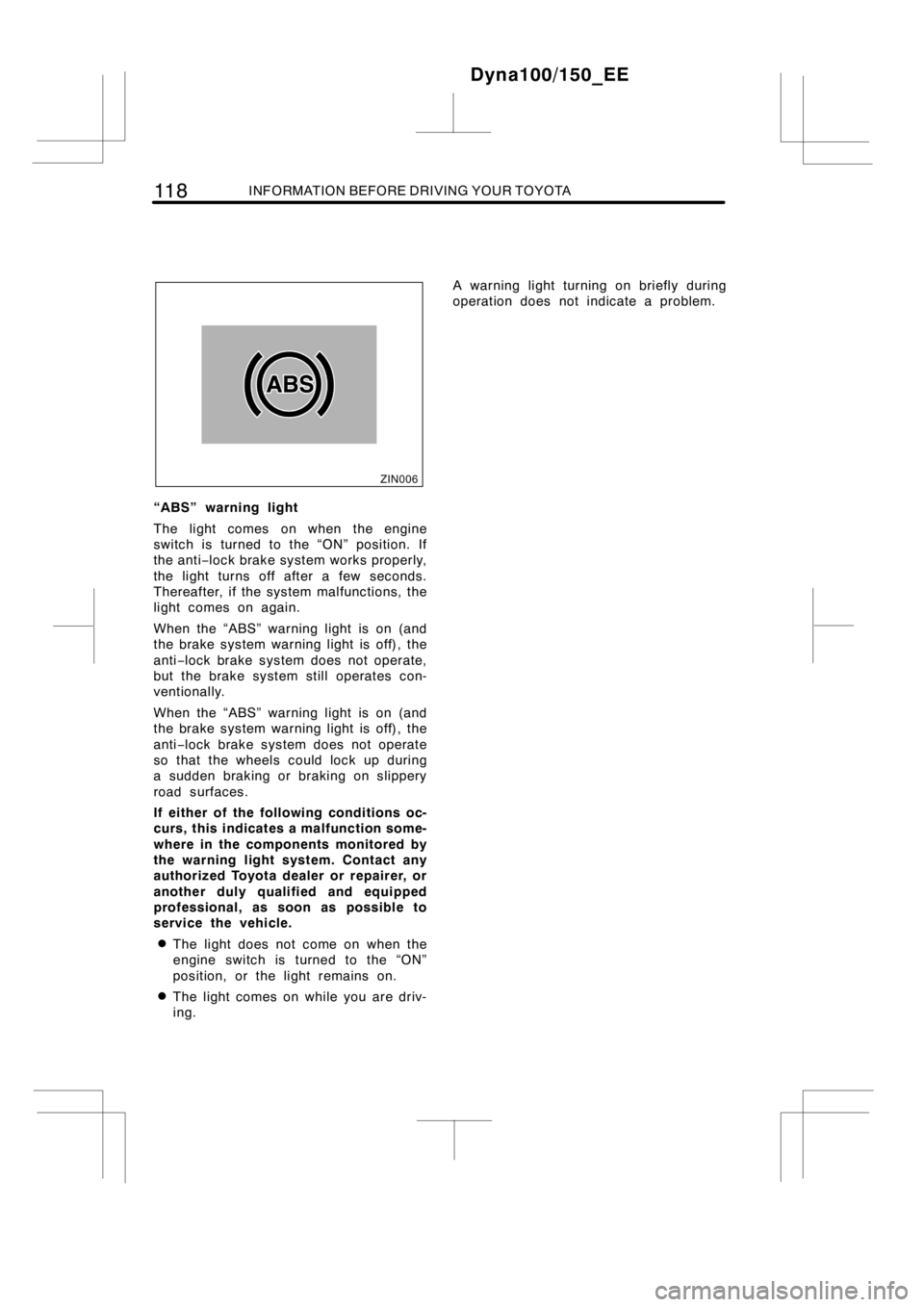Page 107 of 232
OTHER EQUIPMENT101
CAUTION
Do not leave glasses, lighters or
spray cans in the storage spaces, as
this may cause the following when
cabin temperature becomes high:
DGlasses may be deformed by heat
or cracked if they come into con-
tact with other stored items.
DLighters or spray cans may ex-
plode. If they come into contact
with other stored items, the lighter
may catch fire or the spray can
may release gas, causing a fire haz-
ard.
To open the glove box door, pull the
lever.
CAUTION
Keep the glove box closed while driv-
ing. In the event of sudden braking or
sudden swerving, an accident may oc-
cur due to an occupant being struck
by the open glove box or the items
stored inside.
Dyna100/150_EE
Storage precautions Glove box
Page 115 of 232

INFORMATION BEFORE DRIVING YOUR TOYOTA109
FUEL TYPE
Use only diesel fuel.
EU area:
Your vehicle must use only diesel fuel
conforming to European standard
EN590.
Except EU area:
Your vehicle must use only diesel fuel
that contains 50 ppm or less of sulfur
and has a cetane number of 48 or
higher.
CETANE NUMBER
Select cetane number 48 or higher.
Use of fuel with a cetane number lower
than stated will cause persistent heavy
knocking. If severe, this will lead to en-
gine damage.
If your engine knocks...
If you detect heavy knocking even when
using the recommended fuel, or if you
hear steady knocking while holding a
steady speed on level roads, consult any
authorized Toyota dealer or repairer, or
another duly qualified and equipped pro-
fessional.
However, occasionally, you may notice
light knocking for a short time while accel-
erating or driving up hills. This is normal
and there is no need for concern.FUEL TANK CAPACITY
L (gal., Imp. gal.)
Model
�Fuel tank capacity
KDY22160 (15.9, 13.2)
KDY231
KDY25180 (21.1, 17.6)
KDY261
�: See “Model code” on page vi in the
beginning of this manual if you are not
sure of your vehicle model.
Dyna100/150_EE
Page 117 of 232

INFORMATION BEFORE DRIVING YOUR TOYOTA111
DPF system indicator light
If the DPF system indicator light comes
on, the deposit built up in the filter needs
to be regenerated. To regenerate the filter,
the following driving methods are recom-
mended:
DDriving continuously (for example, driv-
ing at approximately 60 km/h [36 mph]
for approximately 20 minutes).
DAvoiding short trips, or by driving con-
tinuously (leaving the engine running
for long periods of time).
DPerform manual regeneration. (with the
DPF system manual regeneration
switch)
The DPF indicator light will extinguish
when regeneration is complete. However,
if this driving cannot be carried out, or if
the light does not extinguish even after
driving, have the vehicle inspected by any
authorized Toyota dealer or repairer, or
another duly qualified and equipped pro-
fessional immediately.
When driving, pay sufficient attention to
weather, road condition, terrain and traffic
conditions, and drive according to traffic
laws.If the DPF system indicator light flashes
�,
perform the following operations:
�: The deposit built up in the filter needs
to be regenerated.
Without the DPF system manual regen-
eration switch—Have the vehicle in-
spected by any authorized Toyota dealer
or repairer, or another duly qualified and
equipped professional immediately.
With the DPF system manual regenera-
tion switch—Perform manual regeneration
or have the vehicle inspected by any au-
thorized Toyota dealer or repairer, or
another duly qualified and equipped pro-
fessional immediately. If regeneration is
not performed and you continue to drive
for a while, the malfunction indicator light
will come on. When the malfunction indi-
cator comes on, manual regeneration can-
not be performed.
Under the following driving conditions, the
DPF system indicator light may come on
earlier than normal.
�:
DWhen only driving at low speeds (for
example 20 km/h [12 mph] or below).
DIf the engine is turned on and off fre-
quently (for example, the engine is not
left running for more than 10 minutes
at a time).
�: Differs in accordance with weather,
driving condition, etc.
For the manual regeneration procedure,
refer to the following instructions.
Dyna100/150_EE
Page 118 of 232

11 2INFORMATION BEFORE DRIVING YOUR TOYOTA
Manual regeneration switch
With the DPF system manual regenera-
tion switch—
To start manual regeneration:
1. Stop the vehicle in a safe place with
the engine running.
Make sure that there are no flammable
materials near the exhaust pipe.
2. Shift the transmission into neutral
and apply the parking brake.
3. Push the manual regeneration
switch.
The DPF system indicator light and the
indicator light on the switch will change
from solid or rapid flashing to slow flash-
ing. The engine idle speed will increase.
In 15 to 40
�minutes, manual regeneration
will be completed and the lights will go
off. The engine idle speed will be reduced.
�: Differs in accordance with the outside
temperature.
Do not depress the accelerator or clutch
pedal after pressing the DPFsystem
manual regeneration switch. Doing so will
stop manual regeneration. If manual re-
generation is stopped, perform manual re-
generation again as soon as possible.
If the engine and exhaustsystem are hot,
such as after driving, manual regeneration
will take less time.
CAUTION
DBe careful not to touch the hot ex-
haust system and stay away from
exhaust gases. During regeneration,
the exhaust gases become hotter
than usual. Never leave flammable
items near the exhaust system.
DDo not drive, idle or park your ve-
hicle over anything that might burn
easily such as grass, leaves, paper
or rags.
Dyna100/150_EE
Page 119 of 232

INFORMATION BEFORE DRIVING YOUR TOYOTA11 3
NOTICE
To prevent damage to the system and
a fire hazard, observe the following
precautions:
zUse only diesel fuel.
zDo not drive for long periods of
time while the DPF system indicator
light is flashing.
zDo not use fuel other than the spe-
cified type.
zDo not use engine oil other than
the recommended type.
zDo not modify the exhaust pipe.
zOperating the vehicle when the en-
gine oil contains a significant
amount of diesel fuel may result in
damage to the engine. If a signifi-
cant amount of fuel is present,
change the oil as soon as possible.
zDo not drive with an extremely low
fuel level; running out of fuel could
cause the engine to misfire, creat-
ing an excessive load on the cata-
lytic converter.
zDo not pull−or push−start your ve-
hicle.
zDo not turn off the engine switch
while the vehicle is moving.
zKeep your engine switch in good
running order. Malfunctions in the
engine electrical system or fuel sys-
tem could cause an extremely high
catalytic converter temperature.
zIf the engine becomes difficult to
start or stalls frequently, take your
vehicle in for a check−up to any
authorized Toyota dealer or repairer,
or another duly qualified and
equipped professional.
zTo ensure that the catalytic convert-
er and the entire emission control
system operate properly, your ve-
hicle must receive the periodic in-
spections required by the Toyota
Maintenance Schedule. For sched-
uled maintenance information, refer
to the “Toyota Service Booklet” or
“Toyota Warranty Booklet”.
Dyna100/150_EE
Page 122 of 232

11 6INFORMATION BEFORE DRIVING YOUR TOYOTA
The tandem master cylinder brakesystem
is a hydraulic system with two separate
sub−systems. If either sub−system should
fail, the other will still work. However, the
pedal will be harder to press, and your
stopping distance will increase. Also, the
brake system warning light may come on.
CAUTION
Do not drive your vehicle with only a
single brake system. Have your
brakes fixed immediately.
BRAKE BOOSTER
The brake booster uses engine vacuum to
power−assist the brakes. If the engine
should quit while you are driving, you can
bringthevehicletoastopwithnormal
pedal pressure. There is enough reserved
vacuum for one or two stops—but no
more!
CAUTION
DDo not pump the brake pedal if the
engine stalls. Each push on the
pedal uses up your reserved vacu-
um.
DEven if the power assist is com-
pletely lost, the brakes will still
work. But you will have to push the
pedal hard, much harder than nor-
mal. And your braking distance will
increase.
ANTI−LOCK BRAKE SYSTEM
(with “ABS” warning light)
The anti−lock brake system is designed
to help prevent lock−up of the wheels
during a sudden braking or braking on
slippery road surfaces. This assists in
providing directional stability and steer-
ing performance of the vehicle under
these circumstances.
Effective way to press the ABS brake
pedal:
When the anti−lock brake system func-
tion is in action, you may feel the brake
pedal pulsating and hear a noise. In this
situation, to let the anti−lock brake sys-
tem work for you, just hold the brake
pedal down more firmly. Do not pump
the brake in a panic stop. This will re-
sult in reduced braking performance.
The anti−lock brake system becomes op-
erative after the vehicle has accelerated
to a speed in excess of approximately 10
km/h (6 mph). It stops operating when the
vehicle decelerates to a speed below
approximately 5 km/h (3 mph).
Depressing the brake pedal on slippery
road surfaces such as on a manhole cov-
er, a steel plate at a construction site,
joints in a bridge, etc. on a rainy day
tends to activate the anti−lock brake sys-
tem.
You may hear a click or motor sound from
the area around the front axle for a few
seconds when the engine is started or just
after the vehicle begins to move. This
means that the anti−lock brake system is
in the self−check mode, and does not indi-
cate a malfunction.
Dyna100/150_EE
Brake system
Page 124 of 232

11 8INFORMATION BEFORE DRIVING YOUR TOYOTA
“ABS” warning light
The light comes on when the engine
switch is turned to the “ON” position. If
the anti−lock brake system works properly,
the light turns off after a few seconds.
Thereafter, if the system malfunctions, the
light comes on again.
When the “ABS” warning light is on (and
the brake system warning light is off), the
anti−lock brake systemdoes not operate,
but the brake system stilloperates con-
ventionally.
When the “ABS” warning light is on (and
the brake system warning light is off), the
anti−lock brake systemdoes not operate
so that the wheels could lock up during
a sudden braking or braking on slippery
road surfaces.
If either of the following conditions oc-
curs, this indicates a malfunction some-
where in the components monitored by
the warning light system. Contact any
authorized Toyota dealer or repairer, or
another duly qualified and equipped
professional, as soon as possible to
service the vehicle.
DThe light does not come on when the
engine switch is turned to the “ON”
position, or the light remains on.
DThe light comes on while you are driv-
ing.A warning light turning on briefly during
operation does not indicate a problem.
Dyna100/150_EE
Page 130 of 232
124STARTING AND DRIVING
1. Check the area around the vehicle be-
fore entering it.
2. Adjust seat position, seatback angle,
steering wheel angle and length.
3. Adjust the inside and outside rear view
mirrors.
4. Close all doors.
5. Fasten seat belts.1. Apply the parking brake firmly.
2. Turn off unnecessary lights and acces-
sories.
3. Press the clutch pedal to the floor and
shift the transmission into neutral. Hold
the clutch pedal to the floor until the
engine is started.
Dyna100/150_EE
Before starting the engineHow to start the engine—
(a) Before cranking